By Major Anita Caldwell
My husband and I left the USA to serve oversees with The Salvation Army in 2001. When we left, The Salvation Army was well loved and respected for the care and compassion shown to those experiencing homelessness. Upon our return, I have wondered if attitudes have changed. I am worried that our national attitude toward “the least of these” has drifted from care and compassion to irritation and impatience. I hope our community can avoid following this trend.
A truly prosperous city has room for all people, it is a city that not only celebrates its success stories but embraces those who are struggling. I hope that as our own city becomes popular and prosperous we are careful not to turn our backs on “the others,” but to open our arms.
The Salvation Army is one of the access points for Waco’s Coordinated Entry Program for homeless families. We are a part of a network of resources available in Waco. Those seeking shelter can come to the Salvation Army to be assessed as to which local program will best serve their need.
When we encounter a person suffering from mental illness, for example, we may refer them to the MHMR PATH program where they are interviewed for appropriate assistance. Sometimes we encounter homeless veterans who just can’t bring themselves to sleep inside. They end up sleeping beside our building which they consider to be a safe place. We connect them to veteran services and the Veteran’s Hospital.
Our primary goal at Salvation Army is homelessness prevention. If a family has an eviction notice, and we have available funds, The Salvation Army can work with the landlord, pay the rent and stop the eviction. This fall, for example, I sat in my office with Helen*, a hard-working mother of one child who works two jobs to pay her bills. Together we reviewed her income and expenses. She concluded that she would need to give up her new car because she simply could not afford the payments. Conversations such as these, also called case management, are a common everyday occurrence at The Salvation Army in each of our programs. We help find the root of the problem and encourage change that sets people free of needing help from others.
If the family is already homeless, we have three small rooms at Sally’s House, The Salvation Army Emergency Shelter for homeless women and homeless families. Our goal is to educate, encourage and support these families as they get employment and move to their own apartments with rapid rehousing funds. Once in their apartments, we continue to have case management conversations that encourage successful changes and help them shift from dependence to independence.
The Homeless Management Information System data from the City of Waco, during three months this past fall, showed that 95 percent of people assisted by The Salvation Army are McLennan County residents – people of this county, this city. These are God’s children who have lost their way. They could be your parent, your spouse, your sister or brother, or your child. They definitely need more services than a meal, and that’s where The Salvation Army asks the harder questions and seeks to find the real answers.
On a recent warm fall evening, I threw a plastic table cloth on the deck of Sally’s House. Three children gathered with their moms as I gave them each paint, brush and canvas. Little wide-eyed Bobby* immediately went for the black and dark colors. You see, this was his first night at the shelter and there were many uncertainties in his little life. It took several words of encouragement before he looked over at Jason’s* painting and decided to go for the brighter colors of green and blue. Jason, on the other hand, painted joyfully. His picture included an open green field, blue sky and bright sun. You see, Jason and his mom had found safety and protection at Sally’s House from a domestic violence situation. Jason’s life was full of hope and happiness.
No matter how society has changed we still know that Jesus calls us to give the cup of cold water to the thirsty and care to the prisoner, the orphan, the widow… the neediest of Waco. He calls us to be the good Samaritan and to take those we find wounded and hurting to the Inn. That’s why we remain steadfast in our mission.
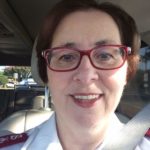 Major Anita Caldwell was born in Olean, NY, to a family of ministers. She attended and graduated from Kentucky Mountain Bible Institute with a BA in Religion. Her MA is in Pastoral Leadership from Olivet Nazarene University. She and her husband, Bradley Caldwell are Majors in The Salvation Army and are Regional Coordinators for this area. They have served as ministers of the gospel in The Salvation Army for 24 years. After serving in three USA appointments, they were transferred as Regional Leaders in Moldova, Romania, Russia and the country of Georgia over a twelve-year period. They received their Waco assignment after serving at International Headquarters in London, UK.
Major Anita Caldwell was born in Olean, NY, to a family of ministers. She attended and graduated from Kentucky Mountain Bible Institute with a BA in Religion. Her MA is in Pastoral Leadership from Olivet Nazarene University. She and her husband, Bradley Caldwell are Majors in The Salvation Army and are Regional Coordinators for this area. They have served as ministers of the gospel in The Salvation Army for 24 years. After serving in three USA appointments, they were transferred as Regional Leaders in Moldova, Romania, Russia and the country of Georgia over a twelve-year period. They received their Waco assignment after serving at International Headquarters in London, UK.
The Act Locally Waco blog publishes posts with a connection to these aspirations for Waco. If you are interested in writing for the Act Locally Waco Blog, please email [email protected] for more information.
*Names changed throughout to protect privacy.
By Christopher Qualls
I work at Indian Spring Middle School in Waco ISD. Though I share that with pride, I am not oblivious to the feelings it conjures up in others. Our school has been in the news for a myriad of less-than-positive reasons over time. Recent history is no exception.
There are several vicious cycles present in our communities’ schools, and I have not the time nor energy to discuss each of those in depth through this platform. However, the most nefarious problem I believe that our students face is the public perception.
While shopping at a local business this weekend, I learned that an employee there had retired from Midway ISD. Interested to find that unique bond shared between wartime trench-friends, I proudly shared my occupation.
“Oh. I bet that’s tough. Those kids have a rougher, street element”
Wait. What.
What does that mean?
Our students at Indian Spring are exceptional.
There is little difference in the students of Indian Spring, Tennyson, Caesar Chavez, G.W. Carver or even Midway Middle.
The problem is not the people; it is the perception of the people.
Our students at Indian Spring are victims of others’ perception. From the time they were in elementary school, the assumption has been that these students are somehow lesser than. There are those in the community that mistakenly underestimate the limitless potential of youth. They assume that these children will grow into underperforming middle school students, high school students, and eventually some sort of scourge on society.
This perception seeps through to the students, and it becomes a self-fulfilling prophecy.
By expecting less of the students at Indian Spring, we are setting them up for failure.
These are good children who have been given up on and underestimated.
If we are going to change the educational climate of Waco ISD, we must first start with the perception we have of the students. That means we must start with ourselves. We must realize that the perceptions we have of our students will either enable or limit their future. More than any skills, we teach young people how to believe in themselves—or not. We wield a dangerous power through our perception. We must use it wisely.
 Christopher Qualls is a Licensed Master Social Worker serving Waco Independent School District as the Afterschool and Summer Enrichment Programs Manager and actively consulting various non-profits on all aspects of programming. He has near 10 years of experience in agencies all over the world, but has spent the past three years living and serving in Waco.
Christopher Qualls is a Licensed Master Social Worker serving Waco Independent School District as the Afterschool and Summer Enrichment Programs Manager and actively consulting various non-profits on all aspects of programming. He has near 10 years of experience in agencies all over the world, but has spent the past three years living and serving in Waco.
The Act Locally Waco blog publishes posts with a connection to these aspirations for Waco. If you are interested in writing for the Act Locally Waco Blog, please email [email protected] for more information.
By Emily Carolin
For the 2017-2018 school year, Baylor launched an exciting set of transdisciplinary courses aimed toward the promotion of human flourishing and the development of innovative approaches to some of the world’s most complex challenges. Under the umbrella of the Social Innovation Collaborative (SIC), Baylor currently has teams of students and faculty collaborating on a wide range of important projects. One of these projects includes the pioneering Water, River, and Community course taught by a wide range of professors from Museum Studies, Economics, Environmental Science, English, Education, and Religion. I was fortunate enough to be one of three Museum Studies graduate students in this course, along with nine other undergraduate students from various disciplines. This unique mix of both professors and students allowed us to delve into a topic from our own backyard.
Water, River, and Community is a problem-based, community-embedded transdisciplinary learning experience that involves students in an exploration of the wicked problem of water. The problems associated with water are difficult to define, without clear solution, socially complex, void of one group who expresses sole responsibility for the problems, and involve many interdependencies. As stated by Ban Ki-moon, former United Nations Secretary General, “Water is the classic common property resource. No one really owns the problem. Therefore, no one really owns the solution.” As a class, we undertook the problem of water and in some cases, worked to find a solution, through lectures, field trips, and assignments.
 At the start of the semester, we took a canoe trip down the Brazos River in conjunction with reading John Graves Goodbye to a River. While we contentedly paddled down the river, we looked to discover our own natural connection with the river while understanding Graves’ personal love for the Brazos River. We saw turtles, various bird and fish, snakes, and encountered one too many spiderwebs strung across low-hanging branches. We caught and identified tiny fish native and non-native to the Brazos River, while discussing the impact of the Whitney Dam on the aquatic life. We explored the heart of the Brazos River Valley first-hand with wet clothes and slightly sunburnt skin.
At the start of the semester, we took a canoe trip down the Brazos River in conjunction with reading John Graves Goodbye to a River. While we contentedly paddled down the river, we looked to discover our own natural connection with the river while understanding Graves’ personal love for the Brazos River. We saw turtles, various bird and fish, snakes, and encountered one too many spiderwebs strung across low-hanging branches. We caught and identified tiny fish native and non-native to the Brazos River, while discussing the impact of the Whitney Dam on the aquatic life. We explored the heart of the Brazos River Valley first-hand with wet clothes and slightly sunburnt skin.
One of my personal favorite assignments and activities of the semester included the development of a survey using Contingent Valuation Method (CVM). This economics-based method allowed us to inquire as to our fellow students’ willingness to pay regarding cleaning up and beautifying Waco Creek on Baylor’s campus. Many students complain of the trash in the creek and recognize it as a major eyesore on Baylor’s campus. We developed questions that probed students as to their recycling habits, opinions on landscaping on Baylor campus, and if they choose to recreationally use the areas around Waco Creek. We proposed a one-time $25 increase to student fee and a subsequent $5 increase to install a bandalong trash collection device that would skim the top of the water for trash and adding planters and seating to other areas of Waco Creek. A high majority of students said they would be willing to increase their student fees to clean up Waco Creek for the betterment of the Waco community. In the future, we hope to expand upon this survey to propose a solution to keep Waco Creek clean. Waco Creek is not just important to the Baylor campus but to all Waco residents; and this is only one example of how our class continually connected the health of a community to the health of a river. We depend on a river just as much as the river depends on us.
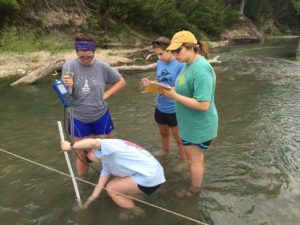 A final assignment brought local fourth-grade students from Bell’s Hills Elementary School to the Mayborn Museum to learn about their local waterways. My group developed an activity, Can You Undo Pollution? It simulated pollution in a river or creek. We took a metal tub of water and filled it with dirt and trash. Students upon walking up the activity were initially disgusted by the tubs, which was just the reaction we were hoping for! By seeing the damage that littering or polluting local waterways can cause, students can better understand how the actions they take affect the world around them. With strainers and tongs, we asked the students to attempt to remove the dirt and trash from the water. While the trash was removed, much of the dirt continued to swirl in the water showing students that pollution is often irreversible. Students then suggested ways that we could act to stop pollution from happening, including: stop littering, recycle, and throw trash away appropriately. We hope that came away from this activity with a better understanding of how their actions affect the health of a river, which in turn will affect their own health in the future.
A final assignment brought local fourth-grade students from Bell’s Hills Elementary School to the Mayborn Museum to learn about their local waterways. My group developed an activity, Can You Undo Pollution? It simulated pollution in a river or creek. We took a metal tub of water and filled it with dirt and trash. Students upon walking up the activity were initially disgusted by the tubs, which was just the reaction we were hoping for! By seeing the damage that littering or polluting local waterways can cause, students can better understand how the actions they take affect the world around them. With strainers and tongs, we asked the students to attempt to remove the dirt and trash from the water. While the trash was removed, much of the dirt continued to swirl in the water showing students that pollution is often irreversible. Students then suggested ways that we could act to stop pollution from happening, including: stop littering, recycle, and throw trash away appropriately. We hope that came away from this activity with a better understanding of how their actions affect the health of a river, which in turn will affect their own health in the future.
While this is only a small glimpse of activities we undertook in the Water, River, and Community, Overall, the course taught me to be more cognizant of my actions and to better appreciate the natural world where we live, while also providing me with a strong background to discuss water policy, ethics, and law. I hope this blog has helped you learn some of the effects that a person can have on a river!
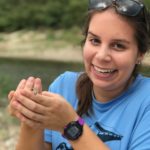 Emily Carolin is a Yankee living the grad school life in the South. She can often be found: devouring books and baked goods, wearing clogs, and wandering in museums. Emily is a graduate student at Baylor University and works at the Mayborn Museum Complex.
Emily Carolin is a Yankee living the grad school life in the South. She can often be found: devouring books and baked goods, wearing clogs, and wandering in museums. Emily is a graduate student at Baylor University and works at the Mayborn Museum Complex.
The Act Locally Waco blog publishes posts with a connection to these aspirations for Waco. If you are interested in writing for the Act Locally Waco Blog, please email [email protected] for more information.
By Major Anita Caldwell
In 1890, William Booth, the founder of The Salvation Army, wrote Darkest England and the Way Out. He envisioned a world where the poor and needy were provided a way out of their poverty. He was convinced that a cab horse was treated with a better standard of living than the poor of London. He opened a work bureau to help people find work. Next, he purchased a farm where men could be trained in various forms of work so they could get employment and gain self-respect. A match factory was operated by The Salvation Army to provide work as well. He laid a foundation for impact assistance.
Serving McLennan County since 1891, The Salvation Army is dedicated to serving the community and being good stewards of donor dollars. Widely recognized for our homeless shelters and community soup kitchen, our services extend far beyond essential needs. While meeting emergency needs is critical, our goal is to identify the underlying causes of crisis and tailor our services to break the cycle of poverty for this and future generations as we guide individuals toward long-term financial stability and independence.
We join Prosper Waco and United Way of Waco – McLennan County in addressing education, financial security, and health along with our providing essential services to those who walk through our doors.
We educate others daily in the following areas:
- Youth – Character building classes, music education, and church youth group activities provide opportunities to continually educate youth with life-long skills to empower them into adulthood and break the cycle of poverty and crisis.
- Homeless – One-on-one case management, life skills classes and employment referrals are provided to homeless families and single individuals to identify and address any educational gaps preventing their success.
- Veterans – Life skills and budgeting classes are offered through one-on-one case management.
- Seniors/Disabled – Our William and Catherine Booth Apartment Complexes provide an affordable housing option for low-income seniors and disabled adults. The Salvation Army also affords education in life skills, health and nutrition, and assistance with home health care benefits to the residents. We connect residents to vocational training, money management, budgeting, lease education and other programs to prevent issues of poverty.
- Inmate Reintegration – Life-skills and job skills are key aspects of our Fresh Start program provided to newly released inmates to guide them toward successful re-integration into the community.
- Red Kettle Employment Program – This program generates on-the-job training for shelter residents.
- Anti-Trafficking Prevention Education – The Salvation Army Officer is an UnBound Professional Trainer and leads prevention training with parents specifically at local churches and community groups.
We work towards financial security in the following ways:
- Homeless Families – Budgeting skills and financial planning are shared with homeless families, singles, elderly, and youth.
- Veterans – Rental assistance and utility assistance are provided to prevent homelessness.
- Christmas Assistance – Budgeting review is provided to Toys for Tots applicants.
- Empowerment Angel Tree Program – A budgeting seminar and follow-up consultation are given to each participant.
- Homelessness Prevention – Helps stabilize families via budget review and financial support.
- Rapid Rehousing – We engage ongoing support/budget counseling until a family is stabilized.
- Red Kettle Employment Program – Assists shelter residents with finances for next steps.
- Seniors/Disabled Booth Apartments – Residents receive benefits/entitlement assistance, case management, crisis intervention, and assistance with tax preparation.
- Fresh Start – Inmate reintegration services include budget education, job search and savings program.
We support those who come to us with their health needs by:
- Women – Health education to homeless women, seniors, other program participants.
- Youth – A range of programs are taught, such as first aid.
- Veterans – Meals and shelter are free for veterans while they gain support through the VA hospital.
- Adult Rehabilitation – For those ready to overcome drug/alcohol addiction, transportation is provided to one of five Salvation Army free addiction treatment centers in Texas.
- Community Hunger – The Community Kitchen provides hot, nutritious meals daily to those facing hunger.
- Warming/Cooling Centers – The Salvation Army Community Kitchen and Family Store serve as community warming or cooling centers during extreme weather, providing respite and replenishment.
- Senior/Disabled – Booth Apartment Complex programs assure adequate nutrition, mental health services, isolation assistance and substance abuse referral as needed.
- Homeless – Referrals to mental and physical health assistance as needed.
- Fresh Start – Inmates receive nutritious meals, counseling, drug/alcohol training and medical assistance.
- Spiritual – The Salvation Army church meets for worship each Sunday at 11 am. All are welcome.
Finally, we support this community with those emergency essential needs:
- Food Pantry – Emergency food to families in need.
- Clothing and Household Vouchers – The Salvation Army voucher program allows those living in poverty and those newly re-housed, including families and veterans, to receive critical supplies free of charge through our Family Store. Furnishings are provided to any victims of fire who have a Red Cross referral.
- Transportation vouchers – Bus tickets.
- Meals – Served daily at The Salvation Army Community Kitchen and during disaster response from the mobile kitchen.
- Emergency Shelters – Short-term crisis housing for men, women and families with children.
- Emergency Disaster Services – Including on-scene disaster assistance, post-event care and crisis intervention through case management.
While some people might think we simply provide “three hots and a cot”, we engage in upending the root causes of need while providing emergency services to those who come through our doors. Please call our office to volunteer in any of these areas as we seek to truly make a deep and lasting difference in McLennan County.
 Major Anita Caldwell was born in Olean, NY, to a family of ministers. She attended and graduated from Kentucky Mountain Bible Institute with a BA in Religion. Her MA is in Pastoral Leadership from Olivet Nazarene University. She and her husband, Bradley Caldwell are Majors in The Salvation Army and are Regional Coordinators for this area. They have served as ministers of the gospel in The Salvation Army for 24 years. After serving in three USA appointments, they were transferred as Regional Leaders in Moldova, Romania, Russia and the country of Georgia over a twelve-year period. They received their Waco assignment after serving at International Headquarters in London, UK.
Major Anita Caldwell was born in Olean, NY, to a family of ministers. She attended and graduated from Kentucky Mountain Bible Institute with a BA in Religion. Her MA is in Pastoral Leadership from Olivet Nazarene University. She and her husband, Bradley Caldwell are Majors in The Salvation Army and are Regional Coordinators for this area. They have served as ministers of the gospel in The Salvation Army for 24 years. After serving in three USA appointments, they were transferred as Regional Leaders in Moldova, Romania, Russia and the country of Georgia over a twelve-year period. They received their Waco assignment after serving at International Headquarters in London, UK.
The Act Locally Waco blog publishes posts with a connection to these aspirations for Waco. If you are interested in writing for the Act Locally Waco Blog, please email [email protected] for more information.
By Fiona Bond
Ever since Creative Waco was formed, just over 2 years ago, we have heard from people of all kinds in Waco about their dreams for making Waco a hub for arts and culture. It’s one of the most enjoyable aspects of our work – hearing about seedling ideas that, with the right support, could grow and bear fruit.
But often those questions were accompanied by a question: “How can we know if this could work?”
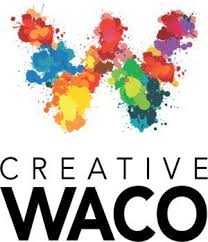 How do we know if Waco is the kind of City that could develop and sustain new art galleries, festivals, theatres, live music venues, artists’ studio spaces, and all the kinds of activity that would really make our city feel like a vibrant, thriving hub of activity that would not only draw residents, but attract visitors, too?
How do we know if Waco is the kind of City that could develop and sustain new art galleries, festivals, theatres, live music venues, artists’ studio spaces, and all the kinds of activity that would really make our city feel like a vibrant, thriving hub of activity that would not only draw residents, but attract visitors, too?
To begin to answer these questions, we turned to that most powerful of storytelling and question-wielding tools – statistics! One of Creative Waco’s first activities was to gather attendance and income/expenditure data throughout the whole of 2016 from Waco’s 29 non-profit arts and cultural venues and programs. This was part of a national survey conducted by Americans for the Arts as part of their “Arts & Economic Prosperity 5” study, which happens across the whole of the USA. This lends considerable kudos to the results and gives the added benefit of allowing us in Waco to compare our findings with peer communities across the nation.
When the results were announced in June, we discovered some fascinating things about Waco. These are stories we want to share as we now work with the Baylor Business School to explore what comes next.
- Waco’s non-profit arts and cultural sector punches above its weight! These organizations and activities (think museums, galleries, live performances, festivals, etc.) deliver $63.7million in economic impact, support 2,184 FTE jobs and contribute $7.4 million in state and local government tax revenue. That’s a whopping twice the economic impact you would expect for a city our size.
- Waco’s non-profit arts and cultural activities bring all kinds of people together! Arts audiences in Waco showed a healthy spread of age, economic and cultural diversity.
- People choose to visit Waco for its arts and cultural activities: Over half of the out-of-town visitors surveyed had come to Waco specifically for the arts event or activity they were attending.
- Waco audiences spend less on “accompanying” experiences such as food
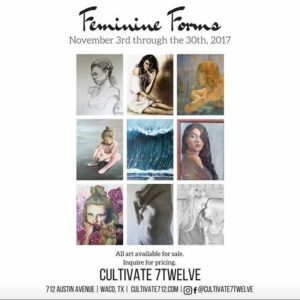 and drink than they do in comparable cities…an average of $5 less per person, actually. The reason appears to be that many of our cultural activities are taking place in venues that don’t offer food and drink, or are not particularly convenient for restaurants, bars or cafes. The Waco Hippodrome, unsurprisingly, stands out as a major exception to that pattern!
and drink than they do in comparable cities…an average of $5 less per person, actually. The reason appears to be that many of our cultural activities are taking place in venues that don’t offer food and drink, or are not particularly convenient for restaurants, bars or cafes. The Waco Hippodrome, unsurprisingly, stands out as a major exception to that pattern!
You can see the full results of this study at creativewaco.org/aep5 and we’d love to hear your ideas about the exciting opportunities for growth presented by these findings. We are also testing these results through practical experiments, such as the wonderfully successful Waco 52 Pop-Up Gallery on Austin Avenue, which combined visual and performing arts with innovative and memorable food/drink experiences in different formats. That concept proved itself strongly enough through August that it has now become a new downtown business: Cultivate 7Twelve. That’s a fantastic story to tell with the help of statistics – and an even better story to be told over a great meal, accompanied by a glass of something locally produced, and surrounded by art!
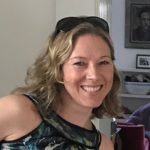 This Act Locally Waco blog post was written by Fiona Bond. Fiona is Executive Director of Creative Waco. She has a background running arts festivals, organizations and cultural projects in her native England and Scotland and is author of “The Arts in Your Church.” In her spare time, she can be found doing an MBA at Baylor, hanging out with husband, Bruce Longenecker, (who teaches religion at Baylor) and their two sons, or playing the bagpipes.
This Act Locally Waco blog post was written by Fiona Bond. Fiona is Executive Director of Creative Waco. She has a background running arts festivals, organizations and cultural projects in her native England and Scotland and is author of “The Arts in Your Church.” In her spare time, she can be found doing an MBA at Baylor, hanging out with husband, Bruce Longenecker, (who teaches religion at Baylor) and their two sons, or playing the bagpipes.
The Act Locally Waco blog publishes posts with a connection to these aspirations for Waco. If you are interested in writing for the Act Locally Waco Blog, please email [email protected] for more information.
By Stephanie Endicott
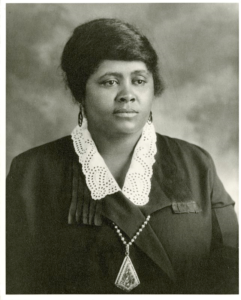 Jeffie Obrea Allen Conner was born in 1895 on her family’s farm in Harrison Switch, Texas. She was the oldest of three children born to Meddie Lilian and Jeff D. Allen. Harrison Switch, later known as Harrison, was a small African American community eight miles southeast of Waco. Conner’s parents, and most other residents of Harrison, owned their own farms. This was notable in a time when the majority of African American farmers in Texas were sharecroppers.
Jeffie Obrea Allen Conner was born in 1895 on her family’s farm in Harrison Switch, Texas. She was the oldest of three children born to Meddie Lilian and Jeff D. Allen. Harrison Switch, later known as Harrison, was a small African American community eight miles southeast of Waco. Conner’s parents, and most other residents of Harrison, owned their own farms. This was notable in a time when the majority of African American farmers in Texas were sharecroppers.
Conner showed great intelligence from a young age, and by 1914, she graduated from Prairie View Normal School, later known as Prairie View A&M, with a teaching certificate. She supported herself by teaching in various McLennan County schools. In 1923, Conner married a prominent Waco doctor, George S. Conner, and moved to his Waco home on 12th Street. Dr. Conner was thirty-one years her senior.
That same year, Conner left her job as a teacher to become a home demonstration agent, employed by the U.S. Department of Agriculture. The demonstration program was founded in 1912 as a way to teach rural girls homemaking skills, but soon grew with the help of federal funding and statewide organization. The program provided support to farming families by supplementing clothing, undertaking home improvement projects, and even funding scholarships.
Due to segregation, Conner was only allowed to work with black women and families. Conner’s childhood years spent on the farm, as well as her training as a teacher, made her an excellent choice for the position. Conner taught women practical lessons, such as homemaking, sewing, basic healing, better farming techniques, and personal hygiene. Due to her influence, rural schools switched from a shared ladle to individual drinking cups for school children, cutting back on the spread of germs. She traveled throughout McLennan County during the week, and stayed with her husband in Waco on the weekends.
Conner furthered her academic studies as well, returning to Prairie View and earning a bachelor’s degree in home economics in 1934. After receiving her degree, she was promoted to supervisor of home demonstration agents, which meant she was in charge of the program for all of Central Texas. She continued to travel during the week, staying in private homes, because segregation kept her from staying in hotels. In 1939, Dr. Conner died. Conner, at the age of forty-four, found herself a widow, once again supporting herself. She returned to school, and in 1944 received her Master’s degree in home economics from Prairie View.
In 1948, Conner left her position with the home demonstration program to become supervisor of the black schools of McLennan County. She found that black schools had far less supplies, inferior accommodations, and a lack of funding compared to the white schools in the county. Conner fought to reform this injustice, and combined the thirty-five smaller schools into fourteen larger ones in order to make the most use of the limited resources available.
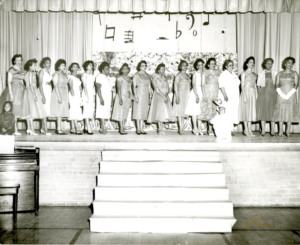 In 1952, Conner retired but continued to live an active and involved lifestyle, persisting in her quest to make a difference in people’s lives. She was part of multiple social sororities, served as president of the Texas Federation of Colored Women’s Club and was influential as a member of the National Association of Colored Women’s Club. In 1966 she was appointed to the State’s Committee on Public School Education by Governor John Connally. Conner continued to be a faithful member of New Hope Baptist Church, and an active member of her community, serving throughout Waco and McLennan County until her death on June 10, 1972 at the age of 76. Jeffie Conner is remembered as one of the outstanding professional women of Waco, paving the way for future black women to follow in her footsteps and make a difference.
In 1952, Conner retired but continued to live an active and involved lifestyle, persisting in her quest to make a difference in people’s lives. She was part of multiple social sororities, served as president of the Texas Federation of Colored Women’s Club and was influential as a member of the National Association of Colored Women’s Club. In 1966 she was appointed to the State’s Committee on Public School Education by Governor John Connally. Conner continued to be a faithful member of New Hope Baptist Church, and an active member of her community, serving throughout Waco and McLennan County until her death on June 10, 1972 at the age of 76. Jeffie Conner is remembered as one of the outstanding professional women of Waco, paving the way for future black women to follow in her footsteps and make a difference.
Cite this post: Stephanie Endicott, “Jeffie Conner,” Waco History, accessed November 8, 2017, http://wacohistory.org/items/show/161.
 Waco History is a mobile app and web platform that places the past at your fingertips! It incorporates maps, text, images, video, and oral histories to provide individuals and groups a dynamic and place-based tool to navigate the diverse and rich history of Waco and McLennan County. It is brought to you by the Institute for Oral History and Texas Collection at Baylor University.
Waco History is a mobile app and web platform that places the past at your fingertips! It incorporates maps, text, images, video, and oral histories to provide individuals and groups a dynamic and place-based tool to navigate the diverse and rich history of Waco and McLennan County. It is brought to you by the Institute for Oral History and Texas Collection at Baylor University.
The Act Locally Waco blog publishes posts with a connection to these aspirations for Waco. If you are interested in writing for the Act Locally Waco Blog, please email [email protected] for more information.
By Vivian Rutherford
As a child, I was very close to my maternal grandmother. Spending many hours with her are some of my fondest memories. She told me stories about her family, her mom, and the grandmother that raised her.
My great-great grandmother had been a slave and most of her children had been sold into slavery except for one child, my future great- grandmother, who had been born during Emancipation.
Those stories along with ones of her childhood, adult and married life instilled in me a sense of pride in who I was and what I could become. She believed in me.
Annie Lee would live to be almost a hundred years old. Even though she could not read or write, education was her top priority for me. I would sit at her feet for hours listening to story after story.
Eventually I began to ask for her specific tales. I shared those stories with other family members. And as I expanded my reading appetite, I included folk tales and fairy tales. Throughout my school years, opportunities would arise, whether they were plays, speech competitions, church productions in which I was able to grow my expertise.
Becoming a children’s librarian was the perfect direction for me. I was able to share old and new favorite stories each week with our youngest patrons and their families.
As a storyteller, I enjoy the almost tangible connection with the audience. I can actually feel them being drawn in. It is an amazing feeling, one that I both cherish and revere.
After being in Waco for several years, I attended the Tejas Storytelling Festival, an annual storytelling event in Denton, Texas. The festival was an eye opener. Not only were there workshops designed to improve and polish storytelling skills, but the organization itself was an umbrella for local guilds scattered throughout Texas, Oklahoma and Louisiana. They catered to individual tellers and groups. The guilds then supported the local tellers who either were professional, wanted to become professional or were just interested in listening to tellers. Being in a guild provided the storytellers a protective environment in which to share and practice their stories.
In 2007, Terri Jo Mosely (who was a Waco Tribune reporter at the time) was attending the festival when we bumped into each other. I was very impressed with the Tejas Storytelling Association and wondered out loud how nice it would be if we had a guild in Waco. Terri Jo immediately asked me, “Why wonder?” “Why don’t you do it?” And I thought, why not?
There was a nearby guild, the Bluebonnet Scots of Mexia, which along with Tejas, mentored and guided us. We were off to a great start. We began with a few members: Leslie Collier (deceased), Julia Bugh, Terri Jo Mosely, Beulah Barksdale, Barbara Bridgewater, Marian Fleischmann, Tom Taylor and myself.
During that first year, we hosted our very first Tellabration! Tellabration is a world-wide national event celebrating storytelling and Waco was a part of it!
The next event added was “Walking Tales” at Oakwood Cemetery. We wanted to combine history with storytelling. Highlighting lives that influenced and helped to build Texas was the ideal option.
In 2016, the Guild was given the green light to facilitate and host for the first time a Tejas Summer Conference in Waco. This Bi-annual conference teaches the storytelling nuts and bolts. The conference included attendees from as far away as New York.
We’ve been able to participate, especially with our youth, in various activities such as Art on Elm Street, Barnes and Noble Storytime, the Cultural Arts Fest, various nursing homes and of course Tellabration!
Ultimately, I would love to see an annual storytelling festival right here in Waco. Storytelling as a community brings families together, strengthens our identity, brings out character, celebrates our diversity and unites us in our commonalities. We are stronger for weaving our stories together.
Teaching the art of storytelling to young people, adults and students is a fun way to preserve and share the art. And, it forever keeps me in the learning mode.
A celebrated moment in my storytelling journey occurred this past Easter, 2016. Several churches came together to create a momentous storytelling event. For several weeks at the Hippodrome, a variety of tellers from diverse backgrounds shared stories and experiences with the Waco community. I was honored to be included. It was a total life changing experience for me!
I see the Heart of Texas Storytelling Guild as a virtual front porch. In days gone by, people would see someone sitting and rocking on the porch. They would sit a spell and talk. Others would stop and join them and before you knew it, the stories would flow.
That’s what we do every 4th Saturday of the month (holiday exceptions).
We let the stories flow. Some are sharing just for the sheer joy of telling, knowing someone is listening with awe. Some are sharing with an agenda, needing specific critiques. Some are there as beginners, gleaning from the many years of experience. Some are there to take it all in and loving every minute. We would love to have you come, sit a spell, tell your story!
Tellabration! 2017
- November 11 @ 6:00 pm – 8:30 pm
- Austin Avenue United Methodist Church (Fellowship Hall), 1300 Austin Avenue
- Tickets: $12/12yrs-adults, $6/4yrs-11yrs
Tellabration! celebrates the ageless art of storytelling. This local event, sponsored by The Heart of Texas Storytelling Guild and celebrated world-wide, is our way of sharing this traditional art within our community. Come enjoy a feast of stories coupled with a fine meal. This year we celebrate Kyndall Rae Rothaus, storyteller, poet and preacher. She is the pastor of Lake Shore Baptist Church in Waco, and the author of Preacher Breath (Smyth and Helwys, 2015).
For more information: Vivian Rutherford, 254-717-1763, [email protected]
www.hotstorytellingguild.org
Heart of Texas Storytelling Guild
What: An Organization of Storytellers and Supporters dedicated to preserving the Art of Storytelling
When: We meet the 4th Saturday of each month (Holiday exceptions)
Adults: 10:30-12 noon Youth: 1:30-3pm
Where: Waco-McLennan County Library, South Branch, 23 S. 18th St. (at dead end of 18th) Waco, TX
Call or email for more information: Vivian Rutherford (254) 717-1763, [email protected] www.hotstorytellingguild.org
 Vivian Rutherford is originally from Houston, Texas. She moved to Waco in 2000 and joined the Waco-McLennan County Library System as a Children’s Librarian. She began The Heart of Texas Storytelling Guild in 2007. She enjoys reading, cooking, listening to music and playing the piano. She is a wife, and mother to 3 kids, 3 cats and 1 dog.
Vivian Rutherford is originally from Houston, Texas. She moved to Waco in 2000 and joined the Waco-McLennan County Library System as a Children’s Librarian. She began The Heart of Texas Storytelling Guild in 2007. She enjoys reading, cooking, listening to music and playing the piano. She is a wife, and mother to 3 kids, 3 cats and 1 dog.
The Act Locally Waco blog publishes posts with a connection to these aspirations for Waco. If you are interested in writing for the Act Locally Waco Blog, please email [email protected] for more information.
In preparing for the Waco Walks “Slightly Spooky Halloween Walk” that will take place tonight, I took a closer look at the Starry Night mural on 10th street between Columbus and Washington. I wondered who came up with the idea and who created the beautiful mural. I had enjoyed the murals on Elm Avenue, but this was one of the first ones I remember seeing on the “Downtown” side of the river. A little Facebook sleuthing resulted in an answer. It was a project of one of Jenny Dougherty’s (now Jamison’s) art classes at Live Oak Classical School. The building is owned by Thad & Loryn Hairston and their son Cullen Hairston was in Ms. Dougherty’s class in 2011. I wrote to Jenny and she wrote me back. I enjoyed her explanation so much, I thought I would share it with you all as a Halloween treat! – Ashley Bean Thornton
 By Jenny Dougherty Jamison
By Jenny Dougherty Jamison
Gosh, I loved that project.
This was before Waco was “cool” (though it’s always been cool to me). Before Fixer Upper etc. etc. I had a dream of making downtown Waco more beautiful.
My 5th grade students study Van Gogh – It’s a pretty powerful subject, conversations about mental illness, the value of art, etc. I looked for a wall all Summer leading up to that school year. Called countless business owners. Finally a parent at Live Oak said he owned a building on 10th. So we went for it.
I had loved Starry Night since I was a kid – I painted it on the bathroom walls of my childhood home. It also lends itself to be painted by middle schoolers and is striking from a distance.
Sherwin WIlliams generously donated the paints. It was much more of an endeavor than I realized. Painting a mural is a bigger project than I’d done before. Not to mention supervising middle schoolers in the wild :).
They did a fantastic job – I’m tearing up writing this. They really did shine in their painting and responsibility around the whole project. My then boyfriend (now husband) and I painted the top third, as we were the only ones who could reach it. John and Kate Sterchi also helped quite a bit and had classes help.
I love seeing this mural pop up in the backgrounds of people’s engagement photos and touristy Waco things. I hope you guys enjoy your walk!
This project serves as a reminder to me that …
- There are really good people in Waco who want to help you succeed in your endeavors.
- Middle Schoolers are far more capable then we give them credit for.
- Even lawyers (my husband) can be taught to paint.
 Jenny (Dougherty) Jamison was an Art Teacher at Live Oak Classical School from 2006-2012. She now lives in Austin with her husband Ryan and son Callaghan. She enjoys painting portraits, making bread and growing vegetables. Most days you can find her and Cal hiking the green belt or in the kitchen. Waco (and Live Oak) will always have a piece of her heart.
Jenny (Dougherty) Jamison was an Art Teacher at Live Oak Classical School from 2006-2012. She now lives in Austin with her husband Ryan and son Callaghan. She enjoys painting portraits, making bread and growing vegetables. Most days you can find her and Cal hiking the green belt or in the kitchen. Waco (and Live Oak) will always have a piece of her heart.
(Last year the Central Texas Artist Collective (CTAC) organized an exhibit downtown called EKPHRASIS. It was an exhibit of art and words. Local poets and artists were paired up to create art and poetry together that was then placed on exhibit in downtown Waco.
This year the EKPHRASIS theme is An Exploration of Mind, Body, Soul. It takes a deeper look at mental health and illness, grief and loss, trauma, recovery, and healing. The hope for this mental health exhibition is to encourage dialogue stimulated by the 19 Artists and Writer’s ekphrastic displays, to destigmatize misconceptions, and to cultivate an empathic understanding of one another.
In today’s blog post, our blogger, Becky Charles shares her thoughts as a visual artist participating in EKPHRASIS. – ALW)
By Becky Charles
Last year wandering around downtown Waco I came across the EKPHRASIS exhibit by chance.
I was just taking a walk after dinner and saw all the beautiful art and poetry that was created by our community and I was in awe. I never imagined I would participate in this type of event.
This spring a friend asked for people to sign up for EKPHRASIS as a birthday gift to her. I thought it was a wonderful birthday wish and I signed up!
I know Jamie Graham through my friendship with her daughter who I met over 25 years ago. She found out I was participating she suggested we collaborate. EEEEE!! I was so excited to create something with her because she is such a creative and amazing person, but I had zero ideas on WHAT to create. My mind was blank.
I might have panicked a little and had a “what was I thinking signing up for this?!?!” moment. I’ve never created art for public viewing nor collaborated with another artist in this way. I’m more of a background volunteer type of person who helps set up, clean up, anything needed to help an event run smoothly. I make art all the time at home to keep or give away as gifts but don’t consider myself an “artist;” it’s just for fun.
Jamie and I met for lunch and there I sat with a brain full of empty. Jamie said she could write a poem inspired by my artwork or I could create art inspired by one of her poems. Since my mind was literally a blank canvas at that point I asked if she could write first and I would create whatever her writing inspired me to. She had a piece she was working on and prefaced it with a very personal story.
I’ve known Jamie most of my life as my friend’s mom, someone to look up to, a mentor, an influence on my development from a teenager to a grown woman, a mother to not only her daughter but to all of us who spent time in her house growing up. She began reading her poem and in that moment I saw her on even ground. At this point in life we are both mothers. In her story of life struggles and her poetry, I saw parts of myself…a woman/mother/person who just wants a moment of peace so she hides in a bathroom behind a locked door. How doors can become barriers or we can open them to freedom. How comforting it can be to isolate yourself at times but then how quickly that isolation can feel like you’re trapped. That we hold the key to the doors we create for ourselves. As Jamie read her poem to me in that restaurant, I saw the art come to life. I was moved to tears by her words and what I envisioned for the art to go with them.
Our creation is simply titled “Doors.” I saw parts of myself in her poem and if you look closely, you will see part of yourself in the art inspired by her words.
 Becky Charles is a Waco native who works for a local mental health clinic. She enjoys spending time with her family, volunteering together for community events, and supporting local businesses, artists, and musicians. She creates many forms of art in her spare time for family and friends but this is her first time to have art on public display.
Becky Charles is a Waco native who works for a local mental health clinic. She enjoys spending time with her family, volunteering together for community events, and supporting local businesses, artists, and musicians. She creates many forms of art in her spare time for family and friends but this is her first time to have art on public display.
(Ira Watkins is an artist from Waco. In 2005, he painted a mural of Dr. Martin Luther King Jr. on the old pier that used to support the Interurban Railroad bridge. Now the old pier with its beautiful mural. serves as an observation deck overlooking the Brazos near the East end of the Suspension Bridge. Mr. Watkins lives in San Francisco, but has family in Waco and still visits frequently. Sarah Frank interviewed him by telephone from his home in California. – ALW)
By Sarah Frank
A few weeks ago I took some time out of my lunch break to visit the Suspension Bridge and take a walk through the park. I stopped for a moment to admire one of my favorite Waco murals, that of Martin Luther King delivering his famous “I Have a Dream” speech to thousands.
As the daughter of a black man I was raised to know African American history. I know all the names by heart, from Rosa Parks and Sojourner Truth, to Emmett Till and Jesse Washington. When I told my dad I was going to school in Waco, I remember him asking “Do you know what happened there?” At the time, I had never put it together that the Waco in which the lynching of Washington occurred was the same Waco I was moving to. I spent the rest of the night searching for other lynchings and racist acts in the Waco area, questioning my own judgement to move there. I had passed through Klan country before and in my terrified state I imagined Waco would be the same.
Four years later, I’m still here and I love Waco more now than ever.
Acts of love and peace like the painting of the MLK mural give me and the rest of the community a sense of hope, which was exactly the intention behind artist Ira Watkin’s painting. A few days after my visit to the mural I had the privilege of interviewing Mr. Watkins about growing up in Waco and the purpose behind the mural. This was the first time I had spoken to an African American native of Waco about the history here, and I was eager to gain a new perspective on my current home and its past.
“I have more flowers in my yard than they do at MLK park”
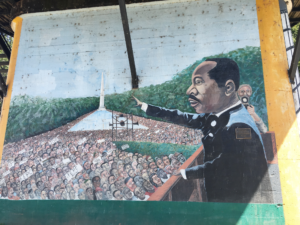 The idea of the mural was originally spawned as a beautification project. Mr. Watkins explained that he had a friend over at his house one day and they were looking through an Ebony magazine. His friend mentioned the lack of beauty in the Martin Luther King Jr. Park and said, “I have more flowers in my yard than they do at the MLK park.” He went on to ask Watkins to paint a mural for the park. Watkins agreed and chose to paint a mural of the images of King that were displayed in an Ebony magazine. Watkins went on to talk about King, mentioning, “To me, it’s like MLK was an inspiration. Sometimes God puts different people on the planet not just to give a message from a religious perspective, but from a humanitarian perspective.”
The idea of the mural was originally spawned as a beautification project. Mr. Watkins explained that he had a friend over at his house one day and they were looking through an Ebony magazine. His friend mentioned the lack of beauty in the Martin Luther King Jr. Park and said, “I have more flowers in my yard than they do at the MLK park.” He went on to ask Watkins to paint a mural for the park. Watkins agreed and chose to paint a mural of the images of King that were displayed in an Ebony magazine. Watkins went on to talk about King, mentioning, “To me, it’s like MLK was an inspiration. Sometimes God puts different people on the planet not just to give a message from a religious perspective, but from a humanitarian perspective.”
“You see these freckles? That’s the n*gger in me.”
After discussing the conception of the mural, I moved on to ask Watkins more about growing up as an African American in Waco and in the United States. He told stories of his old stomping grounds, of what he did for money, and who his friends were. Despite having what seems to me as a relatively normal childhood, Watkins told me a short story which stuck with me:
“When I was there in Waco as a kid, there was one white dude named Ralph that we socialized with and we could go up to his house as long as his parents weren’t there. He had freckles, he always said, “You see these freckles? That’s the n*gger in me.”
Watkin’s story surprised me for two reasons: the fact that he could only go to Ralph’s if his parents weren’t home and Ralph’s comment about his freckles. This story is a product of its time, steeped in prejudice but also in progress. Ralph’s parents illustrate the prejudice at the time – an unwillingness to have a black boy over at their house. Ralph, however, portrays the progress – a boy so accepting that he is okay with having a little bit of black in him.
Despite the racism and prejudice Watkins may have endured growing up, he explains that “[Waco] was great to me because, in my opinion, we had everything that white people had… Everything was basically on the same level.”
“They’d never come back to Waco. They haven’t seen the changes.”
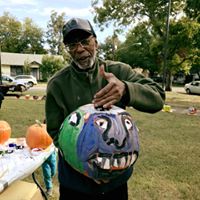
Ira Watkins painting pumpkins with kids in East Waco Park (October 2017)
Speaking with an African American man who grew up in a time of great racial divide, I expected Watkins to be more bitter toward his hometown and his childhood; however, Watkins only had positive things to say about the city. “Waco was alright to me,” he explained. “I have some friends that said they’d never come back to Waco. They haven’t seen the changes. The good thing about it is everyone there is not from there or the surrounding area. They have people there from all over the country, all over the world, and when they come in they come with different ideas. Some of them fall in place with the old guards and some of them bring their own interpretations of what they want it to be.”
“You can’t undo what has been done.”
When asked about Waco’s past, Watkin’s message remained one of hope and progress. Despite the history of racism and prejudice here, Watkins asserts that there has been, and will be, progress in this city. “It’s history, but you can make progress from learning from the past,” explained Watkins when asked about the acts of violence in Waco. He goes on later to attest, “My perspective is that you can’t undo what has been done. You have to live with the past and make strives so that the future can be better.”
My interview with Watkins highlighted the progress Waco has made and motivated me to continue working toward an even better future. His story has also made me realize that Waco is not just its history, but it is its stories, its people, and most importantly its progress.
 Sarah comes from Abilene, Texas and is a senior at Baylor University. She studies Psychology and Professional Writing and hopes to pursue a career in clinical research. She is a dog lover and is known to pull over in her car to stop and pet a dog. She has a hunger for travel and has visited 8 countries and hopes to go to more. A pessimist by nature, but with hope for a better future, she is passionate about civil rights and dreams of a future without borders, hunger, and war.
Sarah comes from Abilene, Texas and is a senior at Baylor University. She studies Psychology and Professional Writing and hopes to pursue a career in clinical research. She is a dog lover and is known to pull over in her car to stop and pet a dog. She has a hunger for travel and has visited 8 countries and hopes to go to more. A pessimist by nature, but with hope for a better future, she is passionate about civil rights and dreams of a future without borders, hunger, and war.
